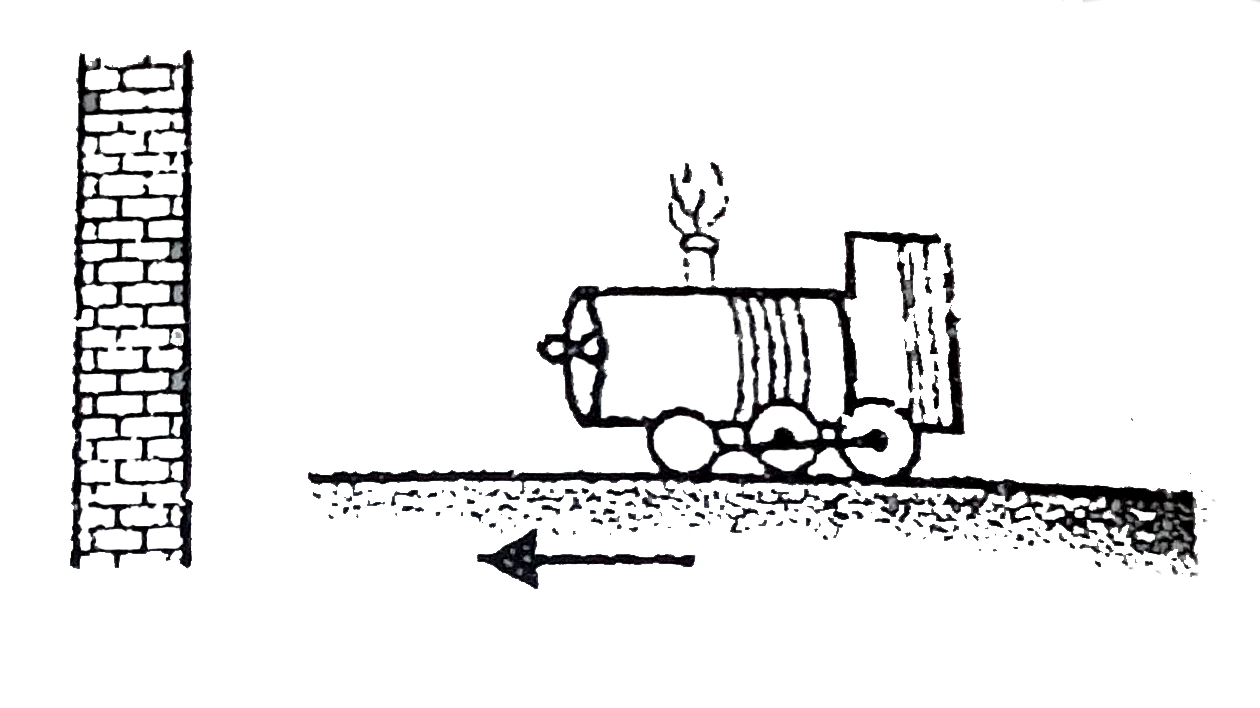A car is moving with 90kmh−1 blows a horn of 150 Hz, towards a cliff. The frequency of the reflected sound heard by the driver will be (speed of sound in air is 340ms−1 )
150 Hz
140 Hz
180 Hz
174 Hz
The correct Answer is:D
To solve the problem, we need to find the frequency of the reflected sound heard by the driver of the car moving towards a cliff. We'll use the Doppler effect formula for sound.
1. Convert the speed of the car from km/h to m/s:
Speed of the car=90 km/h=90×1000 m3600 s=25 m/s
Hint: Remember that to convert km/h to m/s, multiply by 518.
2. Identify the parameters:
- Speed of sound in air, v=340 m/s
- Frequency of the horn, f=150 Hz
- Speed of the observer (the driver), vo=25 m/s (since the car is moving towards the cliff)
- Speed of the source (the cliff), vs=0 m/s (the cliff is stationary)
3. Calculate the apparent frequency when the sound reaches the cliff:
Using the Doppler effect formula:
f′=fv+vov−vs
Substituting the values:
f′=150340+25340−0=150365340
Hint: When calculating the apparent frequency, ensure you correctly identify which object is the source and which is the observer.
4. Calculate f′:
f′=150×365340=150×1.0735≈160.98 Hz
5. Now, this frequency f′ acts as the source frequency when the sound reflects back to the car. Calculate the frequency heard by the driver:
Using the Doppler effect formula again, but now the car is the observer and the cliff is the source:
f′′=f′v+vov−vs
Substituting the values:
f′′=160.98340+25340−0=160.98365340
Hint: Remember that the roles of source and observer switch when the sound reflects.
6. Calculate f′′:
f′′=160.98×365340≈160.98×1.0735≈172.87 Hz
7. Final Result:
Rounding to the nearest whole number, the frequency of the reflected sound heard by the driver is approximately:
f′′≈173 Hz
Conclusion:
The frequency of the reflected sound heard by the driver will be approximately 173 Hz.
Speed of the car=90 km/h=90×1000 m3600 s=25 m/s
- Speed of sound in air, v=340 m/s
- Frequency of the horn, f=150 Hz
- Speed of the observer (the driver), vo=25 m/s (since the car is moving towards the cliff)
- Speed of the source (the cliff), vs=0 m/s (the cliff is stationary)
Using the Doppler effect formula:
f′=fv+vov−vs
Substituting the values:
f′=150340+25340−0=150365340
f′=150×365340=150×1.0735≈160.98 Hz
Using the Doppler effect formula again, but now the car is the observer and the cliff is the source:
f′′=f′v+vov−vs
Substituting the values:
f′′=160.98340+25340−0=160.98365340
f′′=160.98×365340≈160.98×1.0735≈172.87 Hz
Rounding to the nearest whole number, the frequency of the reflected sound heard by the driver is approximately:
f′′≈173 Hz
The frequency of the reflected sound heard by the driver will be approximately 173 Hz.
Topper's Solved these Questions
Similar Questions
A bus is moving towards a gauge wall with a velocity of 5m/s−1. The driver sounds a horn of frequency 200Hz. The frequency of the beats heard by a passenger of the bus will be ………… Hz (Speed of sound in air =342m/s−1)
View SolutionA train is moving with speed 72 km/h towards a hill blows a whistle of frequency 1240Hz. the frequency of echo heard by driver is(speed of sound=330m/s)
View Solution
Knowledge Check
A motor car blowing a horn of frequency 124vib/sec moves with a velocity 72km/hr towards a tall wall. The frequency of the reflectedf sound heard by the driver will be (velocity of sound in air is 330m/s)
A109vib/secB132vib/secC140vib/secD248vib/secAn engine driver moving towards a wall with velocity of 50ms−1 emits a note of frequnecy 1.2kHz. The frequency of note after reflection from the wall as heard by the engine driver when speed of sound in air is 350ms−1 is :
 A1kHzB1.8kHzC1.6kHzD1.2kHz
A1kHzB1.8kHzC1.6kHzD1.2kHzA car is moving towards a fixed wall, it blows form of frequency of 440Hz . The frequency of reflected sound observed by the driver is 480Hz then find the speed of car in km/hr. (Speed of sound is 350msec
A64.78kmhrB26.778 km/hrC54.78kmhrD47.78kmhr
A train moving at a speed of 220ms−1 towards a stationary object emits a sound of frequency 1000 Hz. Some of the sound reaching the object gets reflected back to the train as echo. The frequency of the echo as detected by the driver of the train is (speed of sound in air is 330ms−1)
View SolutionA car with a horn of frequency 16 kHz is moving with a velocity of 72 km/h towards a cliff. The reflected sound heard by the driver of the car has a frequency x×2000 Hz. Find the value of x if speed of sound in air is 340 m/s.
0123456789
View SolutionAn engine blowing a whistle of frequency 133 Hz moves with a velocity of 60ms towards a hiss from which an echo is heard. Calculate the frequency of the echo heard by the driver. (velocity of sound in air in 340ms.)
View SolutionA train moving at a speed of 220ms−1 towards a stationary object emits a sound of frequency 1000 Hz. Some of the sound reaching the object gets reflected back to the train as echo. The frequency of the echo as detected by the driver of the train is (speed of sound in air is 330ms−1)
View SolutionA car moving at a velocity of 17 ms−1 towards an approaching bus that blows a horn at a frequency of 640 Hz on a straight track. The frequency of this horn appears to be 680 Hz to the car driver. If the velocity of sound in air is 340 ms−1 , then the velocity of the approaching bus is
View Solution